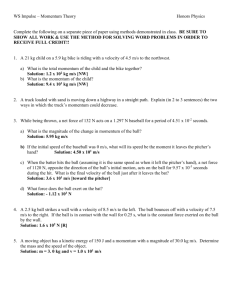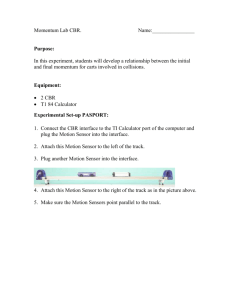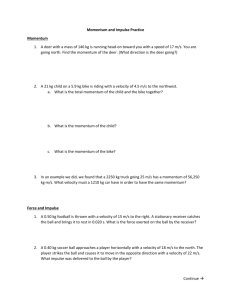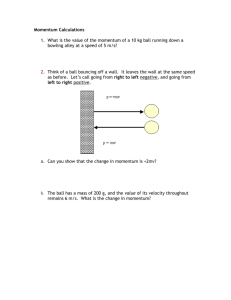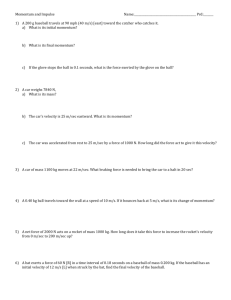Physics 111 Problem Set 8, Chapter 9
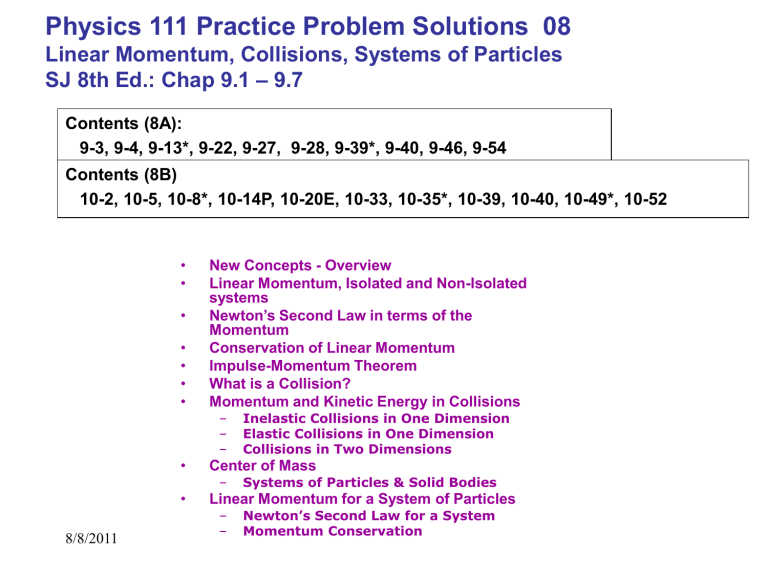
Physics 111 Practice Problem Solutions 08
Linear Momentum, Collisions, Systems of Particles
SJ 8th Ed.: Chap 9.1 – 9.7
Contents (8A):
9-3, 9-4, 9-13*, 9-22, 9-27, 9-28, 9-39*, 9-40, 9-46, 9-54
Contents (8B)
10-2, 10-5, 10-8*, 10-14P, 10-20E, 10-33, 10-35*, 10-39, 10-40, 10-49*, 10-52
• New Concepts - Overview
• Linear Momentum, Isolated and Non-Isolated systems
• Newton’s Second Law in terms of the
Momentum
• Conservation of Linear Momentum
• Impulse-Momentum Theorem
• What is a Collision?
• Momentum and Kinetic Energy in Collisions
– Inelastic Collisions in One Dimension
– Elastic Collisions in One Dimension
– Collisions in Two Dimensions
• Center of Mass
– Systems of Particles & Solid Bodies
• Linear Momentum for a System of Particles
– Newton’s Second Law for a System
– Momentum Conservation
8/8/2011
Problem 9 - 3E: What are (a) the x coordinate and (b) the y coordinate of the center of mass of the three-particle system shown in the figure? (c) What happens to the center of mass as the mass of the topmost particle is gradually increased?
8/8/2011
Problem 9 - 4E: Three thin rods, each of length L , are arranged in an inverted U, as shown in the figure. The two rods on the arms of the U each have mass M ; the third rod has mass 3 M . Where is the center of mass of the assembly?
8/8/2011
Problem 9 – 13P*: A stone is dropped at dropped from the same point at of the two stones at t t = 0. A second stone, with twice the mass of the first, is t = 100 ms. (a) How far below the release point is the center of mass
= 300 ms? (Neither stone has yet reached the ground.) (b) How fast is the center of mass of the two-stone system moving at that time?
8/8/2011
Problem 9 – 22E: A 0.70 kg ball is moving horizontally with a speed of 5.0 m/s when it strikes a vertical wall. The ball rebounds with a speed of 2.0 m/s. What is the magnitude of the change in linear momentum of the ball?
8/8/2011
Problem 9 – 27E: A 91 kg man lying on a surface of negligible friction shoves a 68 g stone away from him, giving it a speed of 4.0 m/s. What velocity does the man acquire as a result?
8/8/2011
Problem 9 – 28E: Two blocks of masses 1.0 kg and 3.0 kg are connected by a spring and rest on a frictionless surface. They are given velocities toward each other such that the 1.0 kg block travels initially at 1.7 m/s toward the center of mass, which remains at rest. What is the initial velocity of the other block?
8/8/2011
Problem 9 – 39P*: A vessel at rest explodes, breaking into three pieces. Two pieces, having equal mass, fly off perpendicular to one another with the same speed of 30 m/s. The third piece has three times the mass of each other piece. What are the magnitude and direction of its velocity immediately after the explosion?
8/8/2011
Problem 9 – 40P: An 8.0 kg body is traveling at 2.0 m/s with no external force acting on it. At a certain instant an internal explosion occurs, splitting the body into two chunks of 4.0 kg mass each. The explosion gives the chunks an additional 16 J of kinetic energy. Neither chunk leaves the line of original motion. Determine the speed and direction of motion of each of the chunks after the explosion.
8/8/2011
Problem 9 – 46E: A railroad car moves at a constant speed of 3.20 m/s under a grain elevator. Grain drops into it at the rate of 540 kg/min. What is the magnitude of the force needed to keep the car moving at constant speed if friction is negligible?
8/8/2011
Problem 9 – 54E*: An automobile with passengers has weight 16,400 N and is moving at 113 km/h when the driver brakes to a stop. The frictional force on the wheels from the road has a magnitude of
8230 N. Find the stopping distance. Modification: Find the stopping time.
8/8/2011
Problem 9 – 54E* Continued: Find the stopping time.
8/8/2011
PROBLEM 10-2:
The National Transportation Safety Board is testing the crash-worthiness of a new car. The 2300 kg vehicle, moving at 15 m/s, is allowed to collide with a bridge abutment, which stops it in
0.56 s. What is the magnitude of the average force that acts on the car during the impact?
8/8/2011
PROBLEM 10-5:
A force that averages 1200 N is applied to a 0.40 kg steel ball moving at 14 m/s in a collision lasting 27 ms. If the force is in a direction opposite the initial velocity of the ball, find the final speed and direction of the ball.
8/8/2011
PROBLEM 10-8*:
Bullets and other missiles fired at Superman simply bounce off his chest (Fig. 10-
27). Suppose that a gangster sprays Superman's chest with 3 g bullets at the rate of 100 bullets/min, and the speed of each bullet is 500 m/s. Suppose too that the bullets rebound straight back with no change in speed. What is the magnitude of the average force on Superman's chest from the stream of bullets?
8/8/2011
PROBLEM 10-14P
The figure shows an approximate plot of force magnitude versus time during thecollision of a 58 g
Superball with a wall. The initial velocity of the ball is 34 m/s perpendicular to the wall; it rebounds directly back with approximately the same speed, also perpendicular to the wall. What is F max
, the maximum magnitude of the force on the ball from the wall during the collision?
8/8/2011
PROBLEM 10-20:
A 5.20 g bullet moving at 672 m/s strikes a 700 g wooden block at rest on a frictionless surface. The bullet emerges, traveling in the same direction with its speed reduced to 428 m/s.
(a) What is the resulting speed of the block? (b) What is the speed of the bullet–block center of mass?
8/8/2011
8/8/2011
8/8/2011
8/8/2011
8/8/2011
8/8/2011
8/8/2011

